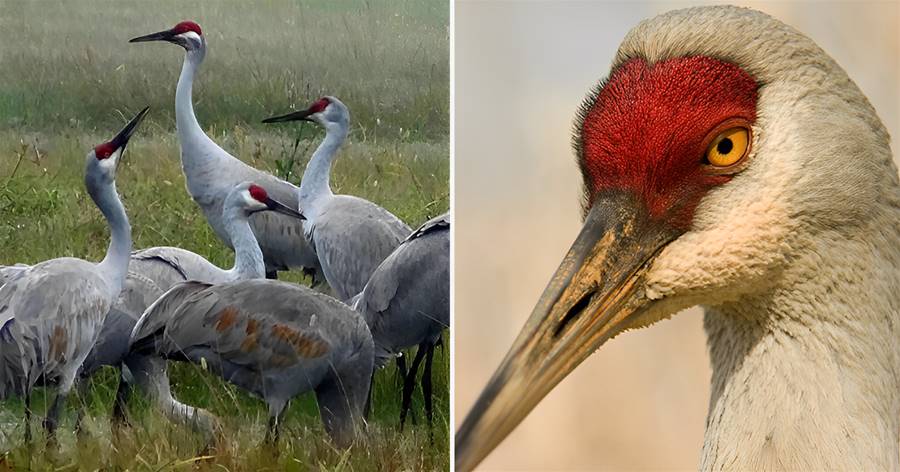

Perhaps you have heard them flying overhead, bugling loudly as they migrate in the classic V-shape. Or maybe you have seen hundreds, or even thousands of them gathering in a marsh. Anywhere you spot them, these large cranes grab your attention. The Sandhill Crane, named for its preference of habitat, migrates in flocks of such numbers than many states have festivals to mark their arrival. In this article we will learn more about these elegant birds, and answer many of the most frequently asked questions about sandhill cranes.
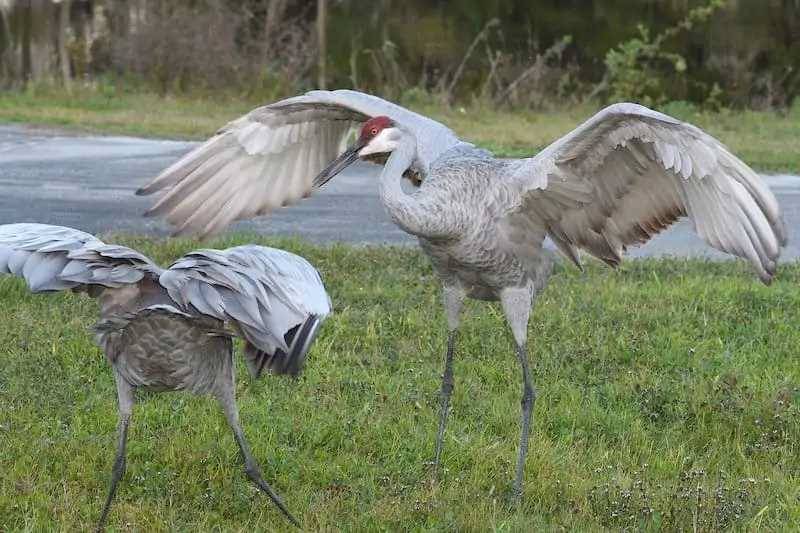
Height: 2.7 ft – 4.6 ft
Weight: males average 10 lbs, females average 8.9 lbs
Wingspan: 5.5 ft – 7.7 ft
Adults are gray overall with some tan feathers on their stocky body. They have a long neck, black beak, black legs, and bright read forehead. Males and females have identical plumage and have no visible differences. Immature cranes lack the bright red crown and have a more “rusty” color, and can have more streaked rusty colored feathers on their body.
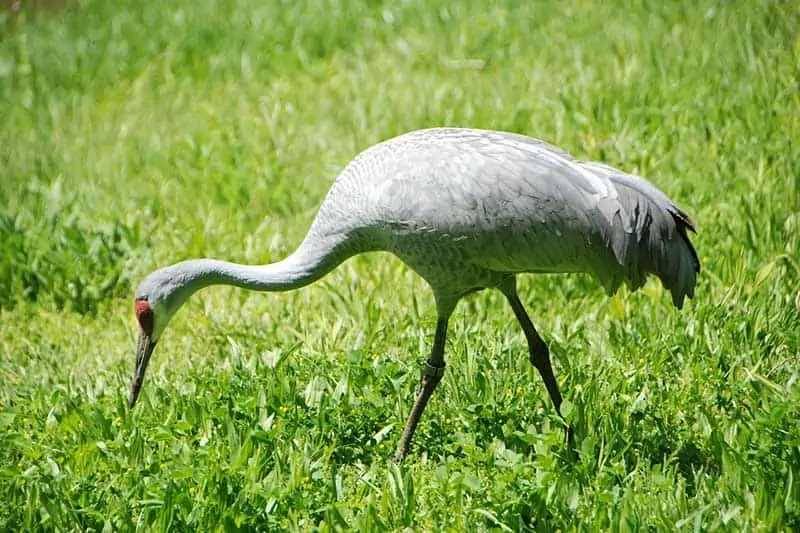
Sandhill cranes choose their mating partner, which they will stay with for life, based on elaborate dancing displays. The pair can jump, bow, bob their head, flap their wings, and even pickup and toss vegetation. They do continue this dancing behavior even past the breeding season.
These cranes breed in wetlands and other habitats where there is standing water. They build a nest mound out of vegetation on the ground or in the shallow water. One to three eggs are laid but often only one chick reaches fledgling age. Chicks will remain under the care of their parents for 9-10 months.
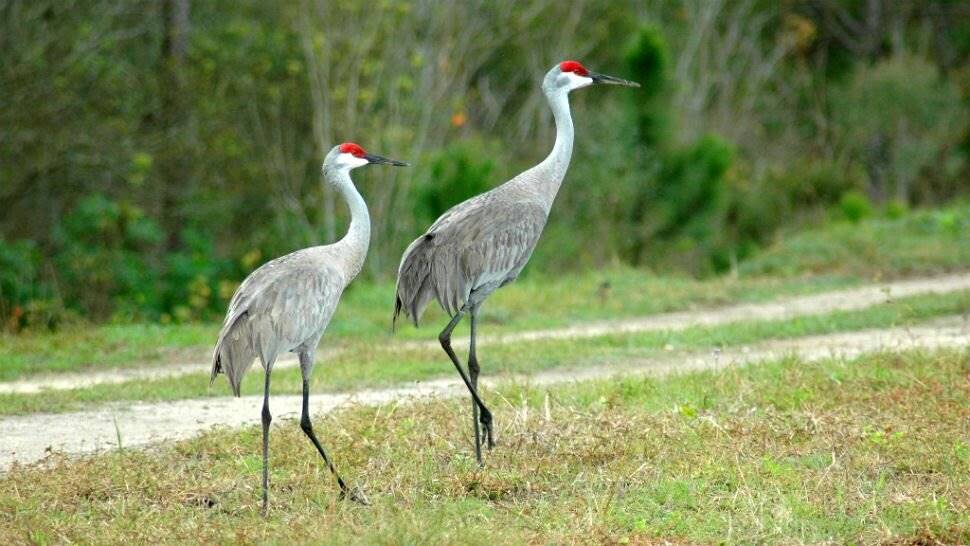
Sandhill cranes are a year-round resident in some areas of Florida, Cuba and Mississippi. However the majority of the population migrates during the fall and spring. Many of the migration groups can be in the tens to hundreds of thousands! Perhaps the best known hot spot is . has some great resources for crane sightings and seeing if there are any hot spots near you.
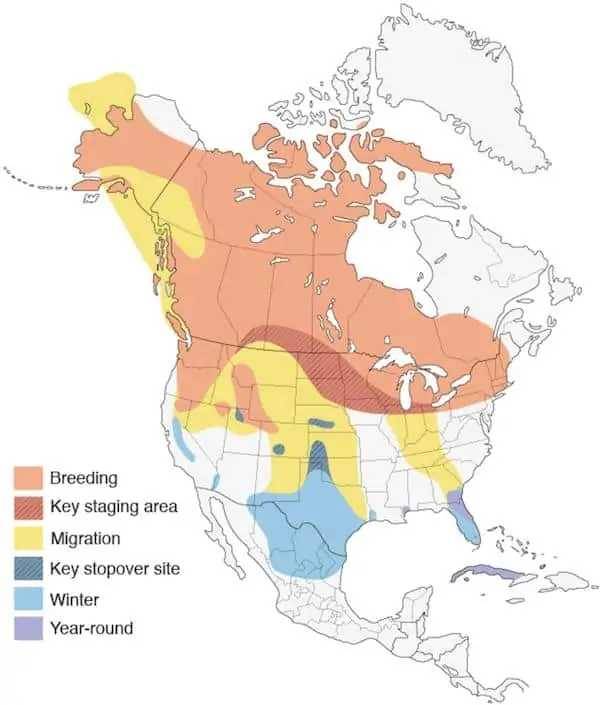
Sandhill Crane Facts
Sandhill Cranes are found throughout many areas of North America, and some in the very corner of northeastern Siberia. They live in open habitats such as bogs, marshes, wetlands, and prairies.
Sandhill cranes stay on the ground to sleep, usually balancing on one leg. They like to stand in shallow water, or along the banks of a wetland area, preferring lots of wide open space with few trees. Sometimes they will tuck their head underneath a wing, sometimes they will just relax their long neck into a more collapsed position.
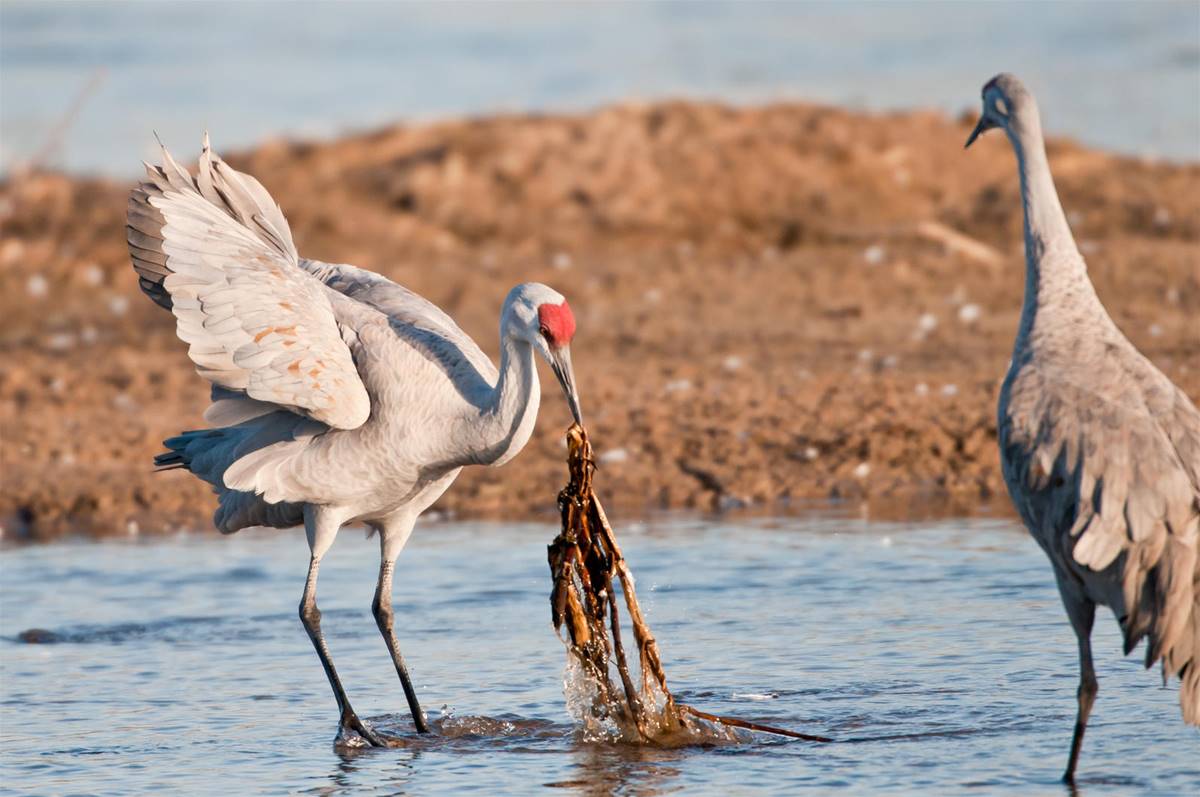
Sandhill cranes can live for 20 – 40 years, however most have a slightly shorter lifespan and the average is closer to 10-20 years. According to Cornell, the oldest sandhill crane on record was 36 years old.
There are a few subspecies of the sandhill crane, so size can vary. The average height range of sandhill cranes is 2 ft 7 inches to 4 ft 6 inches. In general, the cranes that breed the farthest north are a little on the smaller side.
Sandhill Cranes have large wingspans ranging from 5 ft 5 inches to 7 ft 7 inches. This make them excellent soaring birds and they can ride thermals for long periods without having to flap their wings, which saves on energy.

It’s true both sandhill cranes and blue herons are large bids with long necks, long legs, and like to frequent wetlands. However cranes and herons belong to different groups. When flying, herons pull their necks back towards their bodies, while cranes keep their necks fully extended.
The Sandhill crane also has a shorter beak than the long beak a heron uses to catch fish. Cranes tend to be found together in flocks where herons mostly stay solitary.
There are a few choices for the collective noun used for a group of cranes.
Yes, most sandhill cranes will mate for life. In fact they put on great dancing displays to try and attract a partner, and once a pair has bonded they will stay together.
Most eggs are laid between January and May, but this depends on when migration occurs and varies by the different breeding populations. The cranes are typically between 2-7 years old before they begin mating.
No, sandhill cranes as a whole are not considered an endangered species and their population is doing well.
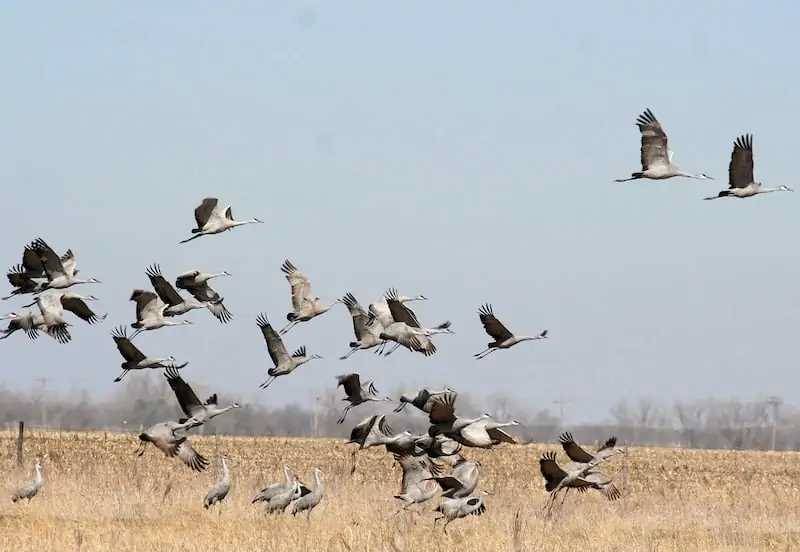
Sandhill cranes are omnivorous, eating both plants and insects/small animals. A large part of their diet are grains and seeds with some berries and tubers. They will also eat insects, snails, reptiles and amphibians. They use their long beaks to probe in the sand and sediment.
In many states it is actually illegal to feed Sandhill Cranes, and it is best not to do so.
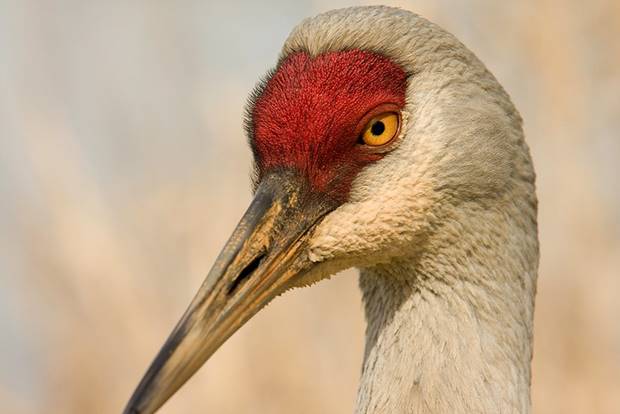
In general, sandhill cranes migrate in the spring and fall. The timing can vary in the fall depending on how harsh the weather is locally, milder conditions in early winter may push migration later. The spring migration back to the breeding grounds tends to be more predictable.
Also, a few populations of sandhill cranes (found in Cuba, and Mississippi) do not migrate at all.
In general, sandhill cranes travel north in the spring to breed, and then head south in the fall. Researchers group sandhill cranes together by “breeding population”, and there are many different populations in North America.
Breeding grounds are found throughout Canada and many northern states including Alaska. Many of these populations will migrate down into southern areas such as Florida, Texas and California.
There are too many distinct breeding populations to mention here, but many states have a spring or fall “crane festival” when the birds are known to stop-over in that area.
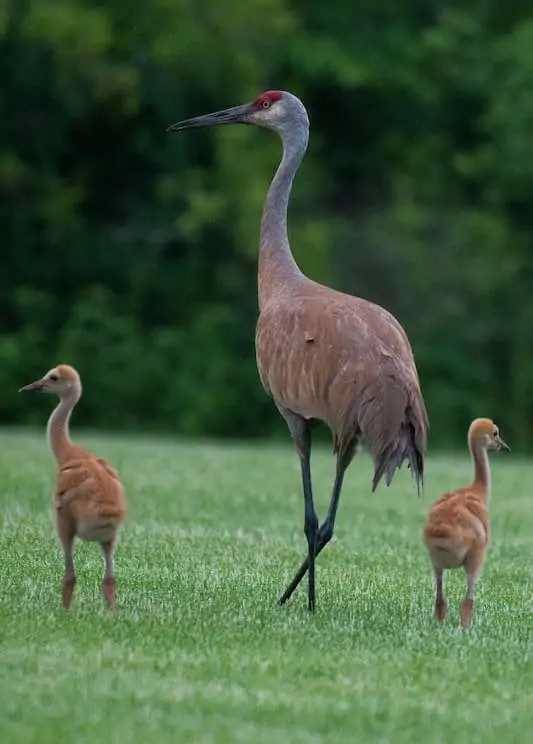
No Sandhill Cranes do not roost, or spend any time in trees. They prefer areas such as wetlands, marshes, cropland and grassland, and to remain standing on the ground.
Like many birds, sandhill cranes aren’t normally very aggressive unless there are eggs and young to protect. Other birds , owls and eagles may try to steal eggs or young chicks. Sandhill cranes will jump up and kick out their long legs to fend off aerial attacks.
For ground predators like coyotes or foxes, they spread out their wings making themselves look larger and more intimidating while hissing.
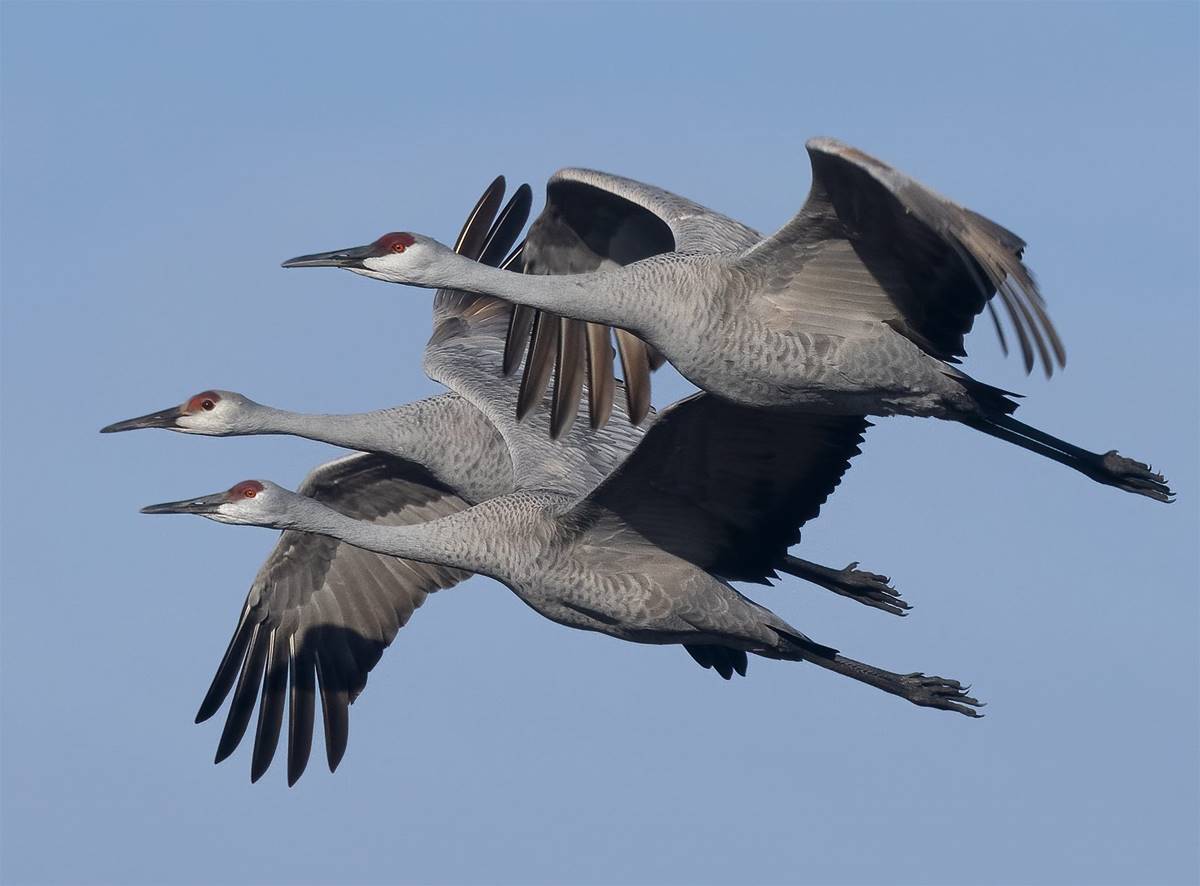
If cranes are plaguing your backyard or garden, there are a few things you can try. If they are hanging around it means you have created a habitat where they can get food, water, and not fear predators. Any water features such as ponds should be fenced in.
Take down bird feeders or use methods to avoid spilled seed that they may be picking up from the ground.
During their long migration flights, sandhill cranes average an altitude of 6,000 – 7,000 feet. Those that have to travel over mountainous terrain, such as the Rockies, can even fly over 13,000 feet.
Typically sandhill cranes will only migrate during the day. Although if weather conditions are good and there is a bright moon, they may occasionally travel at night.
Not all sandhill cranes migrate. But for those that do, they can average 150 – 400 miles per day.
Sandhill Cranes will not return to a specific nest the following year. However as a group the cranes travel to the same breeding grounds year after year.
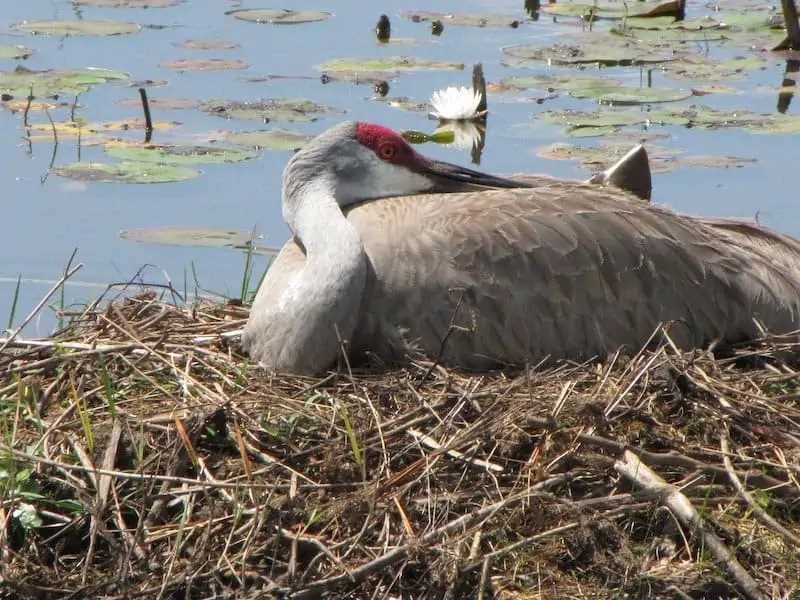
Seventeen states allow hunting of sandhill cranes: Alabama, Alaska, Arizona, Colorado, Idaho, Kansas, Kentucky, Minnesota, Montana, North Dakota, New Mexico, Oklahoma, South Dakota, Tennessee, Texas, Utah and Wyoming.
With so many different breeding groups it is hard to determine accurate populations. From what I was able to find, the population of Sandhill Cranes is approximately 600,000 – 800,000 total including all groups.
Male and female sandhill cranes look identical, so telling them apart can be quite difficult! Unless you see which crane is laying an egg, one of the only clues is through vocalization. Sandhill cranes make “unison calls” which are generally made while traveling to and from feeding, resting and roosting areas.
The males call is lower in pitch and a slightly more drawn out rhythm than the female. He will call out once and the female will respond with two calls. It takes a trained ear to catch this difference, especially if they are overlapping or in a group!
No, sandhill cranes nest on the ground. They prefer isolated wetland areas. They create a mound out of the surrounding grasses, cattails and reeds. Often this mount is sitting in shallow water, but sometimes they will nest on dry land in close proximity to the water.
At the top of the mound they create a smaller cup-shaped bowl lined with smaller pieces of vegetation to lay the eggs in.
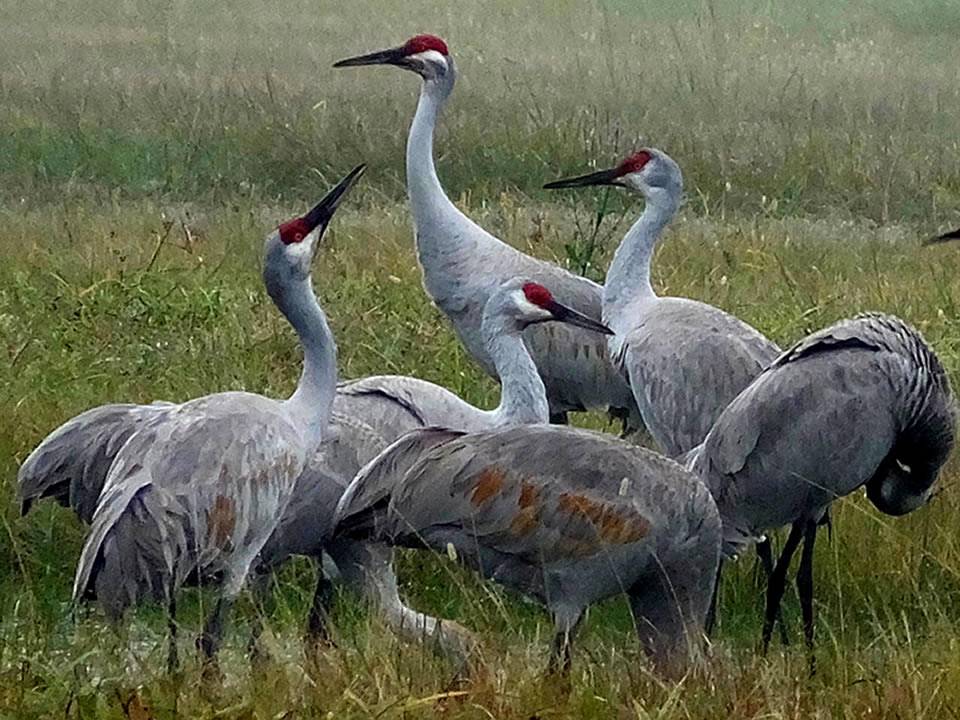
Baby sandhill cranes are often called chicks, but also have the designation “colts”.
Both the mother and father crane will attend to feeding the young. For the first 10 days the chicks are mainly fed “bill to bill” by the parents. As the chicks get a little older they are better able to feed themselves and the parents may drop food at their feet, encouraging them to eat on their own.
The young crane will stay with its parents throughout the winter, and will be about 9 to 10 months old before it separates to join the larger flock.